Abstract
Laboratory microecosystems (microcosms) prepared with a chemically defined sea salt solution were used to study effects of selected environmental parameters on growth and activity of Vibrio cholerae. Growth responses under simulated estuarine conditions of 10 strains of V. cholerae, including clinical and environmental isolates as well as serovars O1 and non-O1, were compared, and all strains yielded populations of approximately the same final size. Effects of salinity and temperature on extended survival of V. cholerae demonstrated that, at an estuarine salinity (25%) and a temperature of 10 degrees C, V. cholerae survived (i.e., was culturable) for less than 4 days. Salinity was also found to influence activity, as measured by uptake of 14C-amino acids. Studies on the effect of selected ions on growth and activity of V. cholerae demonstrated that Na+ was required for growth. The results of this study further support the status of V. cholerae as an estuarine bacterium.
Full text
PDF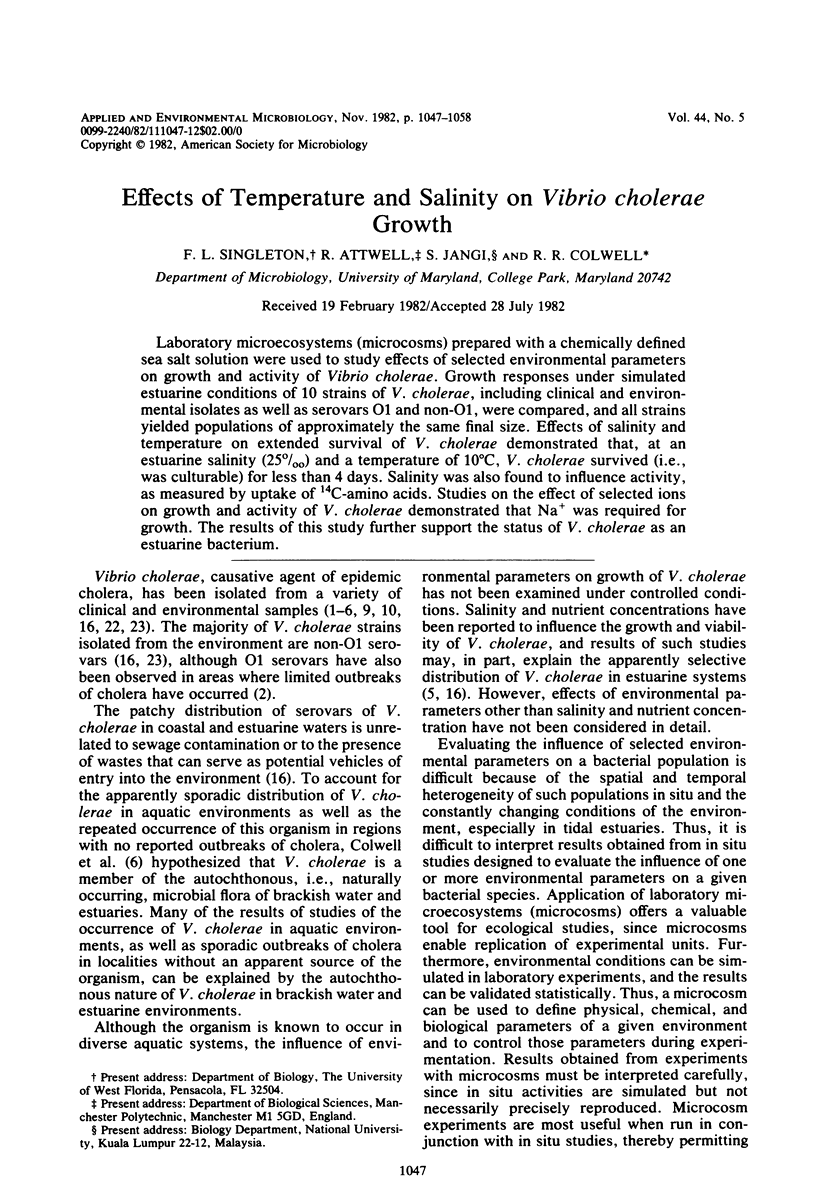
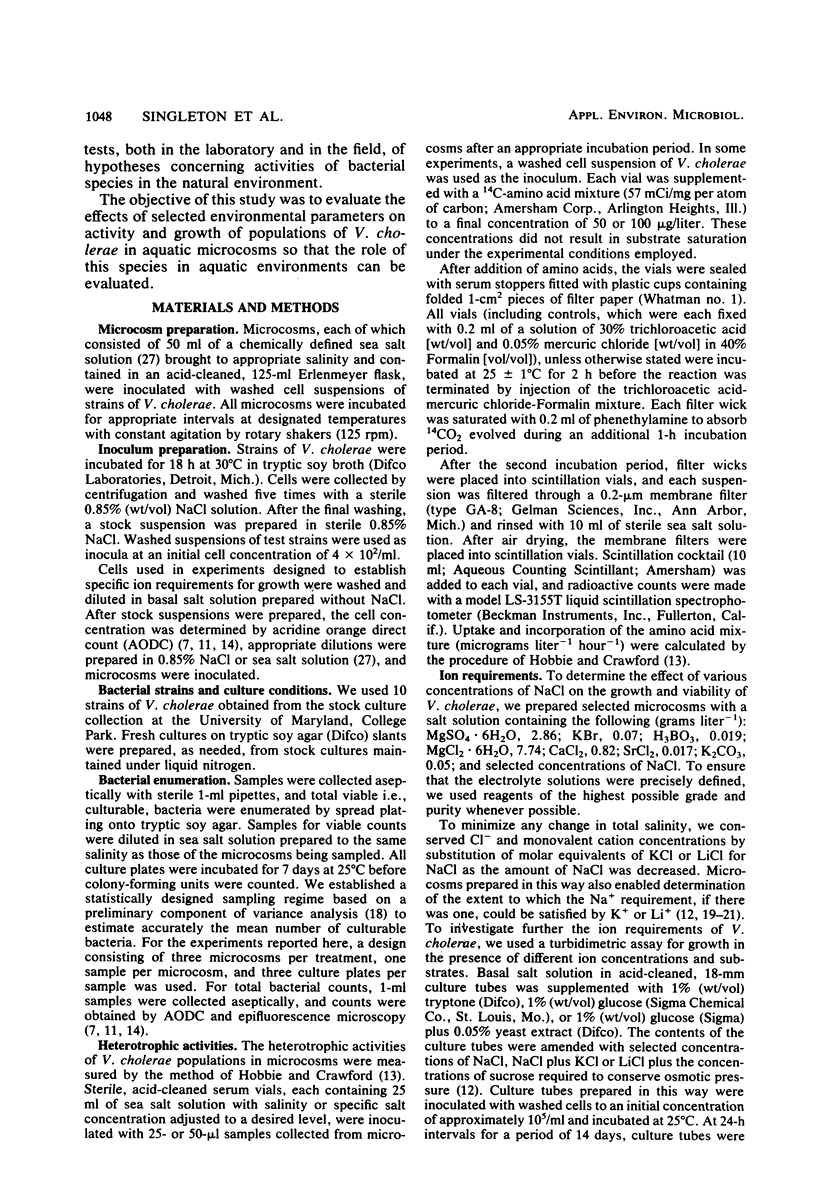


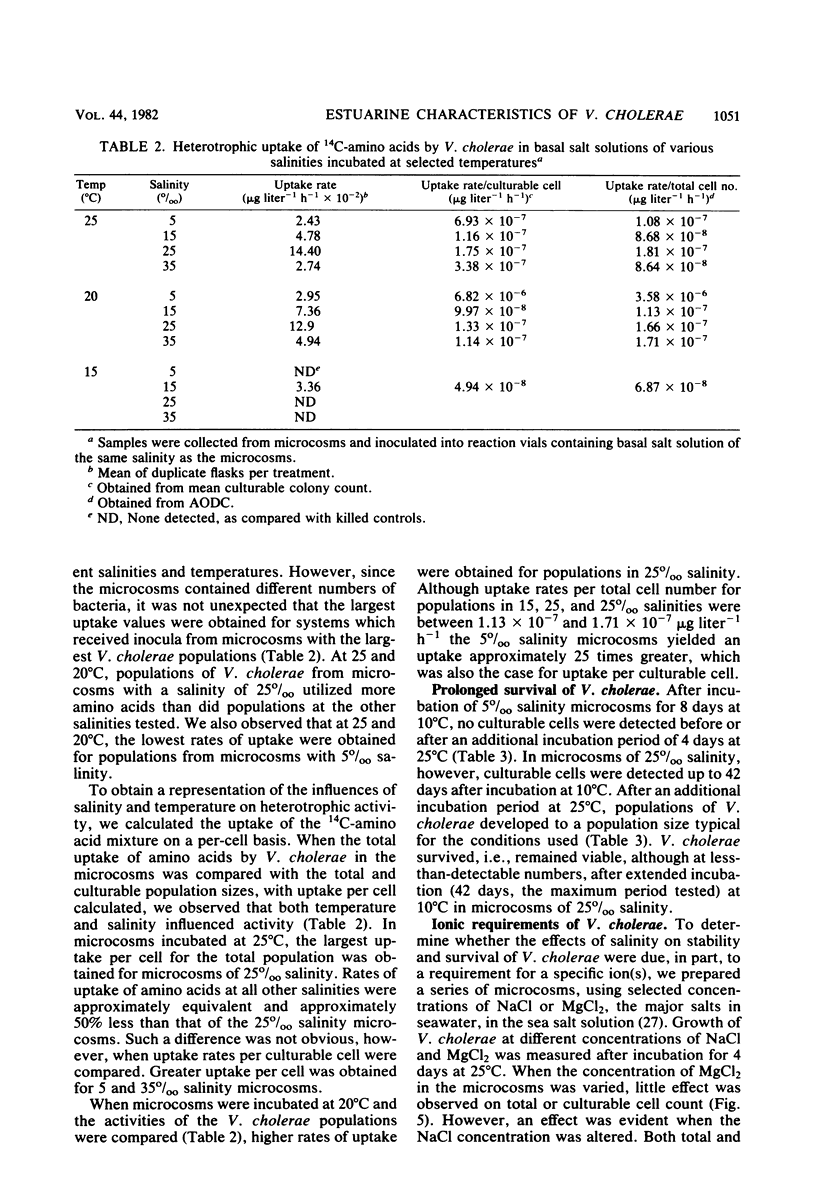




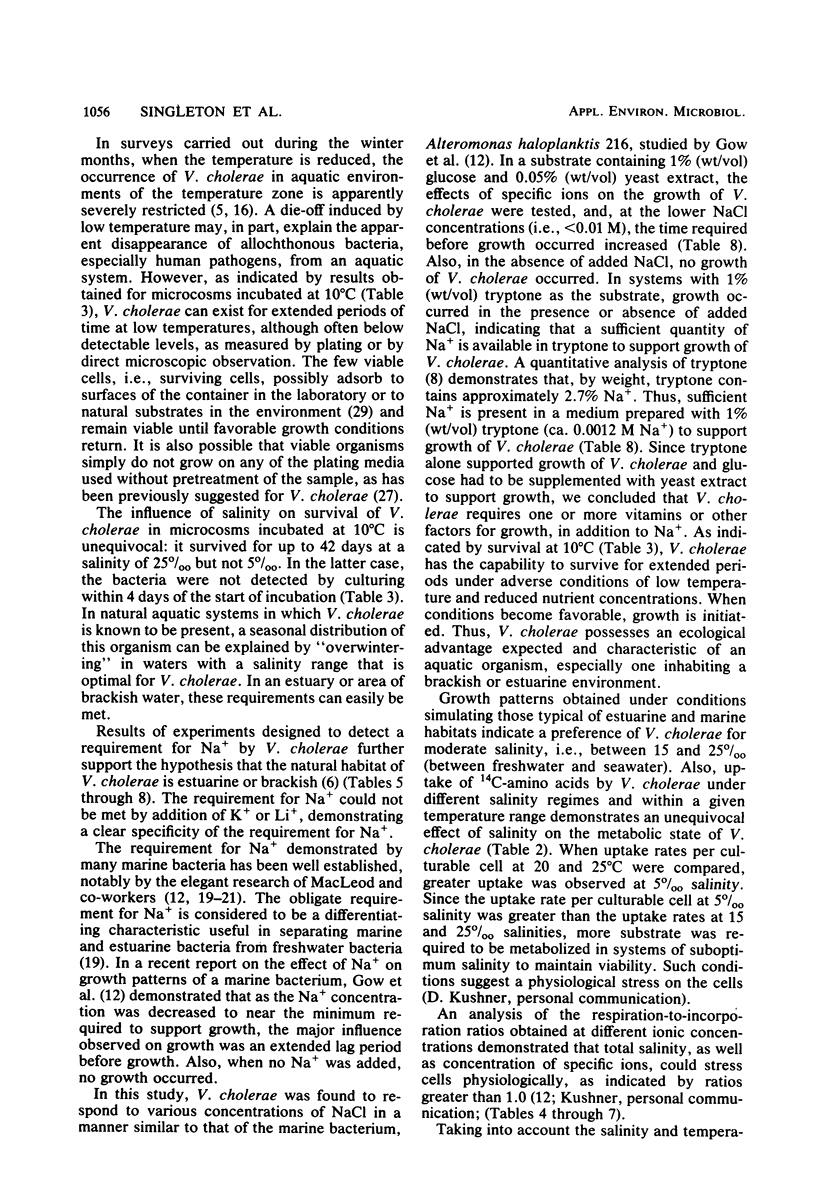
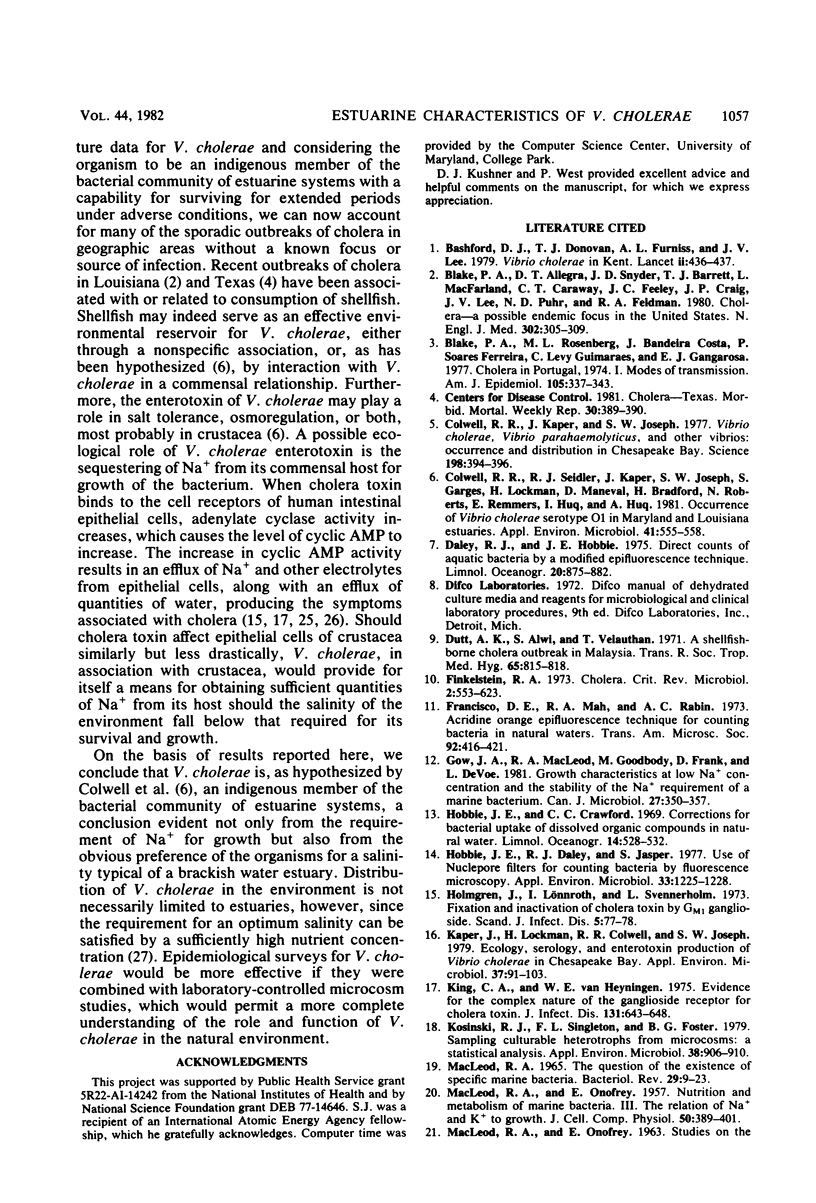

Selected References
These references are in PubMed. This may not be the complete list of references from this article.
- Bashford D. J., Donovan T. J., Furniss A. L., Lee J. V. Vibrio cholerae in Kent. Lancet. 1979 Feb 24;1(8113):436–437. doi: 10.1016/s0140-6736(79)90906-1. [DOI] [PubMed] [Google Scholar]
- Blake P. A., Allegra D. T., Snyder J. D., Barrett T. J., McFarland L., Caraway C. T., Feeley J. C., Craig J. P., Lee J. V., Puhr N. D. Cholera--a possible endemic focus in the United States. N Engl J Med. 1980 Feb 7;302(6):305–309. doi: 10.1056/NEJM198002073020601. [DOI] [PubMed] [Google Scholar]
- Blake P. A., Rosenberg M. L., Costa J. B., Ferreira P. S., Guimaraes C. L., Gangarosa E. J. Cholera in Portugal, 1974.I. Modes of transmission. Am J Epidemiol. 1977 Apr;105(4):337–343. doi: 10.1093/oxfordjournals.aje.a112391. [DOI] [PubMed] [Google Scholar]
- Colwell R. R., Kaper J., Joseph S. W. Vibrio cholerae, Vibrio parahaemolyticus, and other vibrios: occurrence and distribution in Chesapeake Bay. Science. 1977 Oct 28;198(4315):394–396. [PubMed] [Google Scholar]
- Colwell R. R., Seidler R. J., Kaper J., Joseph S. W., Garges S., Lockman H., Maneval D., Bradford H., Roberts N., Remmers E. Occurrence of Vibrio cholerae serotype O1 in Maryland and Louisiana estuaries. Appl Environ Microbiol. 1981 Feb;41(2):555–558. doi: 10.1128/aem.41.2.555-558.1981. [DOI] [PMC free article] [PubMed] [Google Scholar]
- Dutt A. K., Alwi S., Velauthan T. A shellfish-borne cholera outbreak in Malaysia. Trans R Soc Trop Med Hyg. 1971;65(6):815–818. doi: 10.1016/0035-9203(71)90097-6. [DOI] [PubMed] [Google Scholar]
- Francisco D. E., Mah R. A., Rabin A. C. Acridine orange-epifluorescence technique for counting bacteria in natural waters. Trans Am Microsc Soc. 1973 Jul;92(3):416–421. [PubMed] [Google Scholar]
- Gow J. A., MacLeod R. A., Goodbody M., Frank D., DeVoe L. Growth characteristics af low Na+ concentration and the stability of the Na+ requirement of a marine bacterium. Can J Microbiol. 1981 Mar;27(3):350–357. doi: 10.1139/m81-053. [DOI] [PubMed] [Google Scholar]
- Hobbie J. E., Daley R. J., Jasper S. Use of nuclepore filters for counting bacteria by fluorescence microscopy. Appl Environ Microbiol. 1977 May;33(5):1225–1228. doi: 10.1128/aem.33.5.1225-1228.1977. [DOI] [PMC free article] [PubMed] [Google Scholar]
- Holmgren J., Lönnroth I., Svennerholm L. Fixation and inactivation of cholera toxin by GM1 ganglioside. Scand J Infect Dis. 1973;5(1):77–78. doi: 10.3109/inf.1973.5.issue-1.15. [DOI] [PubMed] [Google Scholar]
- Kaper J., Lockman H., Colwell R. R., Joseph S. W. Ecology, serology, and enterotoxin production of Vibrio cholerae in Chesapeake Bay. Appl Environ Microbiol. 1979 Jan;37(1):91–103. doi: 10.1128/aem.37.1.91-103.1979. [DOI] [PMC free article] [PubMed] [Google Scholar]
- King C. A., van Heyningen W. E. Evidence for the complex nature of the ganglioside receptor for cholera toxin. J Infect Dis. 1975 Jun;131(6):643–648. doi: 10.1093/infdis/131.6.643. [DOI] [PubMed] [Google Scholar]
- Kosinski R. J., Singleton F. L., Foster B. G. Sampling culturable heterotrophs from microcosms: a statistical analysis. Appl Environ Microbiol. 1979 Nov;38(5):906–910. doi: 10.1128/aem.38.5.906-910.1979. [DOI] [PMC free article] [PubMed] [Google Scholar]
- MACLEOD R. A., ONOFREY E. Nutrition and metabolism of marine bacteria. III. The relation of sodium and potassium to growth. J Cell Physiol. 1957 Dec;50(3):389–401. doi: 10.1002/jcp.1030500305. [DOI] [PubMed] [Google Scholar]
- MACLEOD R. A. THE QUESTION OF THE EXISTENCE OF SPECIFIC MARINE BACTERIA. Bacteriol Rev. 1965 Mar;29:9–24. [PMC free article] [PubMed] [Google Scholar]
- Merson M. H., Martin W. T., Craig J. P., Morris G. K., Blake P. A., Craun G. F., Feeley J. C., Camacho J. C., Gangarosa E. J. Cholera on Guam, 1974: epidemiologic findings and isolation of non-toxinogenic strains. Am J Epidemiol. 1977 Apr;105(4):349–361. doi: 10.1093/oxfordjournals.aje.a112393. [DOI] [PubMed] [Google Scholar]
- Müller H. E. Vorkommen und Okologie von NAG-Vibrionen in Oberflächengewässern. Zentralbl Bakteriol B. 1978 Sep;167(3):272–284. [PubMed] [Google Scholar]
- Pierce N. F., Greenough W. B., 3rd, Carpenter C. C., Jr Vibrio cholerae enterotoxin and its mode of action. Bacteriol Rev. 1971 Mar;35(1):1–13. doi: 10.1128/br.35.1.1-13.1971. [DOI] [PMC free article] [PubMed] [Google Scholar]
- Sahyoun N., Cuatrecasas P. Mechanism of activation of adenylate cyclase by cholera toxin. Proc Natl Acad Sci U S A. 1975 Sep;72(9):3438–3442. doi: 10.1073/pnas.72.9.3438. [DOI] [PMC free article] [PubMed] [Google Scholar]
- Singleton F. L., Attwell R. W., Jangi M. S., Colwell R. R. Influence of salinity and organic nutrient concentration on survival and growth of Vibrio cholerae in aquatic microcosms. Appl Environ Microbiol. 1982 May;43(5):1080–1085. doi: 10.1128/aem.43.5.1080-1085.1982. [DOI] [PMC free article] [PubMed] [Google Scholar]
- West P. A., Lee J. V. Ecology of Vibrio species, including Vibrio cholerae, in natural waters in Kent, England. J Appl Bacteriol. 1982 Jun;52(3):435–448. doi: 10.1111/j.1365-2672.1982.tb05074.x. [DOI] [PubMed] [Google Scholar]
- Zobell C. E. The Effect of Solid Surfaces upon Bacterial Activity. J Bacteriol. 1943 Jul;46(1):39–56. doi: 10.1128/jb.46.1.39-56.1943. [DOI] [PMC free article] [PubMed] [Google Scholar]


